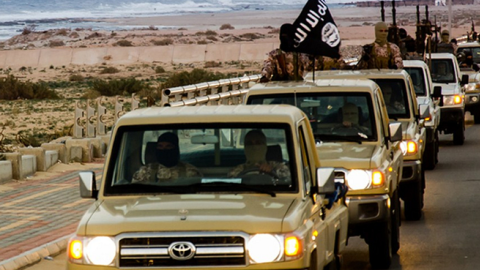The slaughter of 21 Egyptian Christians by Islamic State militants on Feb. 15 took place on the Libyan shore of the Mediterranean. Former Libyan Prime Minister Ali Zeidan recently told the Times of London that unless order is restored in his country, ISIS will secure territory on Libya’s Mediterranean coast within two months. This would increase its potential for attacks in Italy, Greece and elsewhere in Europe. An October ISIS publication pictured St. Peter’s Square under a black flag, and ISIS’s sentiments about Christians are clear.
Greater ISIS access to the Mediterranean would be deeply troubling to the region and a large strategic advance for the terrorist group. ISIS’s prospects for significant naval power are remote. But small boats, fishing vessels, smugglers, and merchant craft that carry concealed weapons could hijack, sink, or rake commercial shipping including cruise liners in the central Mediterranean. This would divide the eastern part of the inland sea from its west and expose Europe’s southern littoral to attacks and kidnappings.
Tehran today wields considerable power over two landlocked capitals of the region, Baghdad and Damascus. Its sea control is more expansive. Besides Iran’s border on the Persian Gulf it is now the major power in Beirut on the Mediterranean and San’a, the capital of Yemen, on the Bab El-Mandeb, the narrow strait that sits astride the southern gateway to and from the Suez Canal.
Turkish naval combatants’ current incursion in the Eastern Mediterranean—to escort a natural gas exploration vessel operating without permission in Cyprus’s exclusive economic zone—has ended the stability that existed in the region since the Cold War standoff between U.S. and Soviet naval forces. And in 2013 Russian President Vladimir Putin announced plans to establish a permanent squadron in the Mediterranean.
In the Cold War era, the U.S. Sixth Fleet, America’s Mediterranean naval force, consisted of two aircraft carriers, an amphibious ready group and escorting vessels. Today it consists of a command ship based in Italy and a handful of destroyers armed with guided missiles based in Spain. In a crisis the Sixth Fleet commander must rely on naval combatants that might be passing through on their way to or from the Persian Gulf.
Some might see this reduction in force as a peace dividend. But the result is diminished American influence in a region that is increasingly unstable.
The risk of military conflict in the Central and Eastern Mediterranean is increasing. Deterrence does not demand ground forces. But at a minimum it does require moving U.S. naval forces eastward from Spain and relying on existing agreements—such as the one that the U.S. has with Greece—to use the naval base at Souda Bay on the island of Crete as the focal point for America’s Mediterranean naval forces.
Last summer, responding to Russia’s slow-motion invasion of Ukraine, then-NATO Secretary General Anders Fogh Rasmussen said that the alliance was planning new bases in Eastern Europe. The alliance should also heed the call of former NATO Supreme Commander Adm. James Stavridis for “more robust maritime deployments both north in the Baltic and south in the Black Sea.”
Shifting naval forces in the Mediterranean to the east makes parallel good sense. A single amphibious ready group would provide a minimum ability to project U.S. power and control the sea. Adding a carrier or a multiple-vessel surface action group capable of striking ISIS targets on land would help stave off the use of the Mediterranean as a highway into Southern Europe for terrorists and their weapons.
Preventing ISIS’s movement to sea in the Central and Eastern Mediterranean would protect navigation in the sea’s extremely busy trade routes and reassure the states of NATO’s southern flank. It would balance Russia’s increasing naval presence in the region and encourage Turkey to reconsider naval action that risks peaceful development of the large natural gas finds in the Eastern Mediterranean.



















